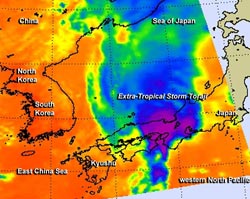Infrared NASA Image Sees Extra-Tropical Toraji Over Japan

NASA's AIRS instrument data took this infrared image of Tropical Storm Toraji as it continued tracking through southern Japan on Sept.4 at 0429 UTC. Purple indicate coldest cloud top temperatures and strongest thunderstorms with heaviest rainfall. Image Credit: NASA JPL/Ed Olsen<br>
The Atmospheric Infrared Sounder or AIRS instrument captured infrared data of Extra-Tropical Storm Toraji as it continued tracking through southern Japan on Sept.4 at 0429 UTC/12:29 a.m. EDT.
AIRS showed that the coldest cloud top temperatures and strongest thunderstorms with heaviest rainfall stretched from Hyogo Prefecture in the southwest to Shiga Prefecture to Gifo Prefecture in the northeast.
At 1500 UTC/11 a.m. EDT on Sept. 4, Toraji had maximum sustained winds near 40 knots/46 mph/74 kph. It was centered near 32.7 north and 132.9 east, about 114 nautical miles/131 miles/211 km south of Iwakuni, Japan. Toraji has increased in forward speed over the last day and was moving to the northeast at 22 knots/25.3 mph/40.7 kph.
The Joint Typhoon Warning Center's multi-level analyses indicated that Toraji is now an extra-tropical cold-core low pressure area, and it is linked to a fast moving frontal boundary. That frontal system is moving across Japan and will carry Toraji's energy with it.
Text credit: Rob Gutro
NASA's Goddard Space Flight Center
Media Contact
All latest news from the category: Earth Sciences
Earth Sciences (also referred to as Geosciences), which deals with basic issues surrounding our planet, plays a vital role in the area of energy and raw materials supply.
Earth Sciences comprises subjects such as geology, geography, geological informatics, paleontology, mineralogy, petrography, crystallography, geophysics, geodesy, glaciology, cartography, photogrammetry, meteorology and seismology, early-warning systems, earthquake research and polar research.
Newest articles

Making diamonds at ambient pressure
Scientists develop novel liquid metal alloy system to synthesize diamond under moderate conditions. Did you know that 99% of synthetic diamonds are currently produced using high-pressure and high-temperature (HPHT) methods?[2]…

Eruption of mega-magnetic star lights up nearby galaxy
Thanks to ESA satellites, an international team including UNIGE researchers has detected a giant eruption coming from a magnetar, an extremely magnetic neutron star. While ESA’s satellite INTEGRAL was observing…

Solving the riddle of the sphingolipids in coronary artery disease
Weill Cornell Medicine investigators have uncovered a way to unleash in blood vessels the protective effects of a type of fat-related molecule known as a sphingolipid, suggesting a promising new…





















